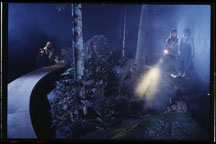| << Back |
Cultural Scene and Heard: Lovin’ the Nightlife – “In the Dark” at Springs Preserve
By Chad Felix
In darkness, whether under the vast, starry blanket that is the night sky or in even stranger locales where light rarely wanders, we humans become a little less audacious and a little more helpless. The problem is remedied simply enough. We light a fire, flick on a light switch, or tap a button on our cellular phone, but still there is something incredibly humbling about humans in darkness, especially when contrasted against the many species so much more adept to live in it. “In the Dark,” the latest exhibition from Springs Preserve, serves as a fun and informative tribute to the creatures that we, for reasons obvious enough, hardly see and rarely even consider.
Putting Some Springs in Your Step
The visionary 180-acre plot that makes up Springs Preserve is a cultural mash-up of galleries, museums, living collections, installations, gardens, etc. and resembles, more or less, a southwestern version of Los Angeles’ well-known J. Paul Getty Museum and Conservation Institute. Springs Preserve is remarkable in that, through its size and design, it virtually eliminates the feeling of being in the city. The architecture is sleek but never overstated, and the beauty of the natural landscapes throughout surround visitors and then, upon their taking in a breath of that fresh air, engulfs them whole. Fittingly, “In the Dark” resides inside the Origen Museum, a dimly lit building that also houses a student art gallery and Las Vegas history exhibit. Away from the sunlight and most of the foot traffic, “In the Dark” beckons passers-by with eerie sounds of the night: a housecat gently meowing, crickets chirping and an ever-so slight breeze swimming in and out of the vegetation of a cool forest.
Who Turned Out the Lights?
For the exhibit, the space has been filled with prime examples of environments that exist in darkness. Dioramas big and small depict everything from the chemosynthetic vents of the ocean deep, wildlife scenes of the night and the earthen worlds just beneath our feet. Informative games and activities educate and entertain as participants mimic clicking like a bat or swimming like a jellyfish. Here, it doesn’t take much to learn a whole lot. Throughout the exhibit, colorful signs offer diagrams, pictures and concise explanations as to how these life forms have adapted and evolved to live without light. You’ll learn how certain salamanders, after spending years in the cool, damp climates of deep caves, now reside there exclusively, no longer equipped to life outside of them. Furthermore, you’ll witness how deep ocean wildlife uses light in less common ways–anglerfish dangle it in front of them to attract their prey; certain jellyfish flash it in predator’s faces; and some squid and fish use it to blend in.
Perhaps most interesting are the examples of the human scientific endeavors that even the playing field between the skills of the nocturnal world and ourselves. Sonar and radar, like that of whales and bats, help us to communicate information through the deep and the dark, and heat-vision goggles help us locate body heat like a vampire bat. All of these things and more make “In the Dark” a pleasurable and instructive experience that can be enjoyed by all ages. Upon reentering the sunlit spaces outside of Origen, I felt humbled, and I couldn’t help but further ponder the diverse lives of all of those creatures in the dark.
The exhibit is a limited-time engagement at Springs Preserve that runs until May 15th and is just one of the many reasons to pack up the family and head down. The breathtaking grounds alone warrant a visit, with presentations like “In the Dark” as icing on the cake. So make a day of it! You can even take a break for lunch at Wolfgang Puck’s Springs Café. The Preserve is open daily from 10 a.m. to 6 p.m. For more info on Springs Preserve, “In the Dark” and other events, visit www.springspreserve.org or call 822-7700.








